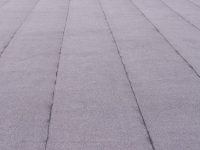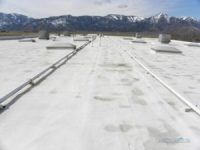Quality commercial roofing
As we prepare to answer that question, “Are TPO roofs good?” what TPO roof mean? Those three letters are the abbreviations for many things, depending on the topic of conversation. In this article, the topic is roofing for commercial and industrial structures. These types of structures typically have single-ply membrane roofing.
There are two core types: EPDM (Ethylene Propylene Diene) and TPO (Thermoplastic Polyolefin), which is the subject of our article. There is a difference in the chemical makeup of these two roofing materials, there are different installation processes, and the energy efficiencies are different. So, TPO roof, what is it that makes it a preferred choice of roofing material?
The TPO roof benefits that attract many commercial and industrial building owners are:
- Low Installation Cost: A TPO roof has a low install cost compared to other flat roofing materials. The average cost for a TPO roof can range between $5.00 per square foot up to $8.00 per square foot.
- Durable: A TPO roof is resistant to algae, bacteria, debris, dirt, UV rays, and chemical exposure. A TPO roof can withstand impact damage, punctures, and tears, making it an excellent material for a building that may have frequent contractor foot traffic for electrical, HVAC, plumbing, and storage.
- Flexible: A TPO roof coating is flexible and lightweight, making installation easier, faster, and with fewer seams to be secured. These are factors that equate to lower cost in labor, making the overall install price cheaper than other flat roofing materials.
- Energy Efficiency: A TPO roof provides a commercial or industrial structure energy efficiency that is ideal for a building owner and property manager. A TPO roof provides tremendous savings on cooling fees and is environmentally friendly, thanks to the light color reflectiveness. Available in gray, tan, or white, a TPO roof surface exceeds the requirement of the EPA’s energy star guidelines, excellent for structures in areas where the temperatures are hot most of the year.
Does TPO have an R-value?
It is common knowledge to have a higher the R-value, the better the performance for any roofing material, and a TPO roof isn’t any different. For a commercial or industrial roof system, the R-values of roofing material is only part of the equation. Other components that contribute to the overall R-Value is the underlayment, cover boards, and the adhesive used to install a TPO roof. The R-Value based on the thickness of the TPO roof application is 0.24 in a typical installation.
Is TPO waterproof?
A TPO roof is installed from large rolls that are hot air-welded together, creating seams that make it a waterproof material for a low slop commercial or industrial building. A TPO roof does not absorb UV rays, instead of reflecting them, which helps with the cooling costs of the entire structure, easing the energy bills and creating less carbon footprint. A TPO roof is 100% recyclable, making it an eco-friendly roofing material.
What is the life expectancy of a TPO roof?
A TPO roof is one of the pre-fabricated sheet roofing material that guarantees you consistent quality. It is a flexible but strong material that offers long-lasting durability for the building owners. For contractors, it offers efficient installation utilizing a reinforcement scrim between the two plies.
With a top and bottom thickness of 35/65, the top ply contains pigments of Cool Roofing along with the UV stabilizers we’ve discussed. Combined with the other components in TPO roofing, it has an extended lifespan that provides a consistent weld with the bottom ply, top ply, and fillers. The material comes with a warranty of 25 years. With the experience of professional commercial roofing, the roof system can give a TPO roof a lifespan of up to thirty years.
How do you maintain a TPO roof?
Any roofing material should have a routine of cleaning, inspecting, and maintenance, and a TPO roof is not any different. These three things will help the TPO perform well for a long lifespan. Cleaning should be considered one part of the general maintenance routine to ensure the solar reflectance and keep it energy efficient. Routine cleaning will keep the algae and other plant growth at bay, as well as the infestation of birds and pests.
The most common way to cleaning the TPO roof is by using a cleaning solution with a pressure washer, protecting the base flashings and low curbs, and run-off of the cleaning solution. Professional commercial roof contractors will typically start with a low-pressure for the top layer to remove dirt and dust. Then, using a long-handled, soft-bristled brush for scrubbing the cleaning solution with care not to damage the TOP roof material. The contractor will then rinse with the same low-pressure and then inspect the roof for damage, repairing as they go.
If you’re interested in a TPO roof with insulation, do a Google search for “tpo roof installers near me” and ask neighboring buildings which they have used and if they were satisfied with the work. When installed professionally and maintained as recommended, a TPO roof will give your commercial or industrial structure many years of use. Call 775.358.7663 today for your TPO roofing needs.




